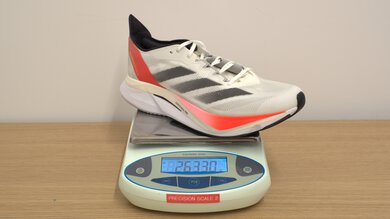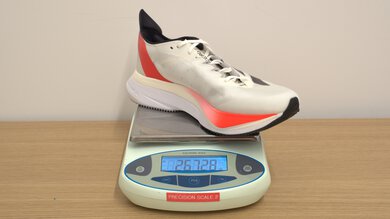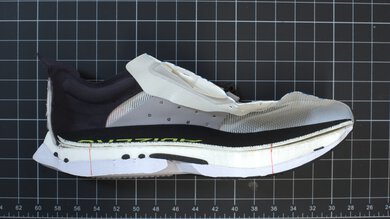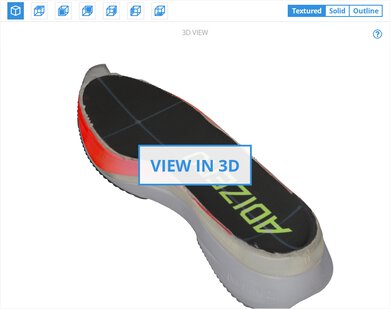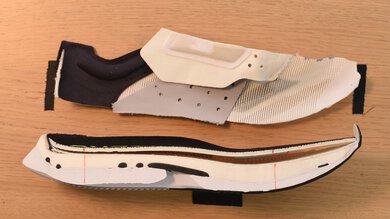The adidas Adizero Boston 12 is a versatile marathon trainer intended for easy runs to light tempo intervals. The twelfth iteration of the well-loved Boston series features two midsole layers - the bottom is a firmer EVA foam and the top is a softer, more premium Lightstrike Pro foam. Sandwiched between these two layers are fiberglass ENERGYRODS, while the outsole features Continental rubber for reliable traction. However, these features come at the cost of weight, making the shoe quite heavy overall.
Our Verdict
The adidas Adizero Boston 12 offers reasonable performance for marathon racing. Its ENERGYRODS and great lateral stability give it a dependable feel over long distances, though the shoe is notably limited by its mediocre energy return, higher-than-ideal weight, and insufficient cushioning. As a result, it's best suited to runners prioritizing stability rather than plush comfort over 26 miles.
-
ENERGYRODS add stiffness.
-
Great stability.
-
Heavy weight limits its efficiency.
-
Not enough bounce for racing.
The adidas Adizero Boston 12 is a good choice for short races. Its firm forefoot and fiberglass rods translate into effective toe-offs at faster paces. However, its heavier weight and only okay energy return prevent it from standing out among the best racing shoes for shorter, speed-driven competitions.
-
ENERGYRODS add stiffness.
-
Foam is firm.
-
Heavy weight limits its efficiency.
-
Not enough bounce for racing.
The adidas Adizero Boston 12 provides adequate energy return, particularly noticeable in the forefoot, due to its strategic placement of premium Lightstrike Pro foam. This makes it effective at facilitating an energetic toe-off, especially when running at quicker paces. However, the disappointing heel energy return can feel somewhat lifeless, reducing the overall responsiveness of the shoe, particularly for heel strikers looking for smooth transitions.
-
Forefoot energy return is decent.
-
Heel energy return is lacking.
The cushioning of the adidas Adizero Boston 12 falls short, offering limited protection underfoot. Both heel and forefoot cushioning feel rather thin, contributing to an uncomfortable ride, especially for longer runs or heavier foot strikes. As a result, runners seeking more protective cushioning may find it overly harsh for extended use.
-
Feels quite harsh on feet.
The adidas Adizero Boston 12 has impressive lateral stability, feeling highly secure underfoot. Its broad outsole and firm foam provide great stability even when fatigue sets in. This makes the shoe particularly valuable for runners who need reliable foot control during longer distances or when maintaining form becomes challenging.
-
ENERGYRODS add stiffness.
-
Great stability.
-
Foam is firm.
- 6.7 Marathon Racing
- 7.7 5K/10K Racing
Performance Usages
- 6.9 Energy Return
- 5.4 Cushioning
- 8.1 Lateral Stability
Changelog
- Updated Apr 02, 2025: Converted to Test Bench 0.8.
- Updated Apr 02, 2025: Review published.
Differences Between Sizes And Variants
We tested the adidas Adizero Boston 12 in men's US size 9, as noted on the label. The color shown here is Cloud White/Aurora Metallic/Solar Red. This model is also available in other colorways, such as Core Black/Cloud White/Carbon and Blue Spark/Zero Metallic/Cobalt Blue. Wide versions are offered for both men and women, including the Chris Nikic Edition, which features a distinct orange colorway and iconography for the 1% Foundation. While visually unique, this edition shares the same specifications as the standard model.
Compared To Other Running Shoes
The adidas Adizero Boston 12 stands out among daily trainers primarily for its excellent stability, making it a reliable choice if you need solid underfoot support. However, while the shoe excels in stability, some competitors, like the Saucony Endorphin Speed 4, offer similar stability but with a more cushioned and responsive feel.
Within Adidas's lineup, this shoe sits below the versatile adidas Adizero Evo SL, which provides superior cushioning, responsiveness, and a lighter build, making it better for racing despite lacking rods. If you need a true racing flat, look towards the more specialized super shoes like the lighter, faster adidas Adizero Adios Pro 3 or the newer adidas Adizero Adios Pro 4.
For more options, check out our recommendations for the best running shoes to find the perfect pair.
The adidas Adizero Boston 12 and the adidas Adizero Evo SL are two versatile options from the German giant, but despite the Boston 12 being named after a major marathon, you're probably better off racing one in the Evo SL. This is thanks to the Evo SL's superior cushioning, lighter build, and more responsive midsole. The Boston, however, remains the better choice if you highly value stability and prefer its full-length ENERGYRODS.
The Saucony Endorphin Speed 4 and the adidas Adizero Boston 12 are both versatile, stable daily trainers but differ notably in feel and cushioning. The Saucony provides more cushioning, a softer midsole, and better energy return, making it smoother and more responsive for faster workouts or races. It's also lighter than the adidas, making it a more versatile partner for daily runs.
The adidas Supernova Rise and adidas Adizero Boston 12 occupy different spots within the adidas lineup. The Boston 12 is a more premium trainer that incorporates fiberglass ENERGYRODS for extra stability and a mix of EVA and more premium TPEE foam. It's a lighter shoe that's designed for mid to long-distance training. On the other hand, the Supernova Rise is designed to be an all-arounder, with a softer heel and a more energetic ride for faster paces.
The Brooks Hyperion Max 2 and the adidas Adizero Boston 12 are both plated super trainers, but each has distinct strengths. The adidas features full-length carbon rods and a firmer forefoot, making it more snappy and better suited for shorter races. The Brooks, on the other hand, uses a nylon plate combined with a softer, more cushioned midsole, offering a more forgiving and comfortable ride for your interval sessions.
The adidas Adizero Boston 12 and HOKA Mach X are both super trainers designed to provide support for everyday runs. The adidas offers superior stability. However, it's less cushioned but still heavier, making it feel harsher and less agile. This means the HOKA is more versatile and more comfortable for most runners, especially over longer distances or varied training efforts.
Test Results
Heel energy return in this model is sub-par, leaving heel strikers with a flat and uninspiring sensation. The midsole, constructed primarily with a top layer of EVA foam at the heel limits the shoe's overall responsiveness.
Forefoot energy return is decent, thanks to the predominance of premium, TPEE-based Lightstrike Pro foam in this area. This foam noticeably improves the shoe's bounciness, creating a more energized and springy toe-off. Forefoot strikers, in particular, will appreciate the energy the shoe provides, especially at faster paces.
This shoe offers disappointing heel cushioning, feeling somewhat minimal. The heel area provides limited protection, and runners seeking substantial comfort or shock absorption underfoot might find the experience harsh or uncomfortable, particularly on extended runs or harder surfaces.
Forefoot cushioning is poor in this shoe, presenting an overly minimal underfoot feel. The underfoot protection here is especially lacking, resulting in discomfort during prolonged sessions or for runners who prefer softer rides.
This model has a firm heel, especially at lower to medium force impacts, providing a stable and secure feeling upon landing. However, as impact forces increase significantly (such as for heavier runners or during faster runs), the shoe will feel softer than other models like the adidas Supernova Rise but isn't overly soft either. This will particularly appeal to runners who prioritize control and a stable ride over plush comfort.
The forefoot of this shoe extremely firm, providing a stable platform across all force levels. This substantial firmness enhances the shoe’s overall stability, making it suitable for faster-paced runners. However, runners looking for a soft underfoot experience should look elsewhere.
Comments
adidas Adizero Boston 12: Main Discussion
Let us know why you want us to review the product here, or encourage others to vote for this product.
Update: Updated the Stereo Dynamics, Stereo Frequency Response With Preliminary Calibrations, and Surround 5.1 results with new methodology from Test Bench 1.3 and accompanying text. Added text to Audio Latency: ARC, Audio Latency: HDMI In, and Audio Latency: Optical boxes.


